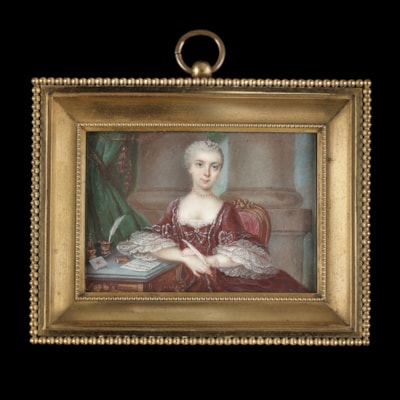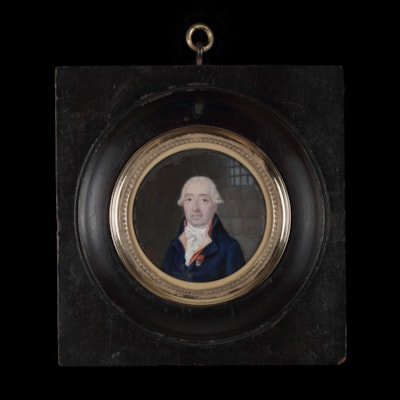FRENCH SCHOOL (18th century)
Pair of portrait enamels of husband and wife Sir William Wheler (1702-1763), 5th Bart of the City of Westminster and Lady Penelope Wheler (née Glynne) (1706-1740); he wearing blue coat and red waistcoat; she in white open-fronted gown with lace underdress
Circa 1730
Ovals, each 3.1 (1 ¹/₄ inches) high
Enamel on copper
Set into gold clasp mounts with mother of pearl reverses (2)
SOLD
Born in Leamington-Hastings, co. Warwick, Sir William matriculated from Magdalen College, Oxford University at the age of fifteen in 1720. William married Penelope Glynne in 1726, moving his young family to Paris from Warwickshire a few years later. The couple’s first son, Francis, became an army officer – their second, John, held the position of Prebendary of Westminster, with their third son, William, inheriting the 6th baronetage from his father. As his brother, Charles (who inherited the 7th baronetage) was born in Paris, we can assume that this pair of enamels were painted during this sojourn.
This pair of enamels would have originally been set into a pendant or bracelet to be worn – the mother of pearl backs attesting to such a setting. To have one’s portrait painted in enamel in the first half of the eighteenth century was extremely fashionable – the technical innovations and the bright colours bringing a new look to the traditional format of the portrait miniature painted in watercolour on a vellum or ivory support. In England, Zincke may have been the couple’s first choice – but in Paris, where Jean Petitot and his son monopolised the art form almost a century earlier, there were plenty of fine enamellists.
Most enamellists in Paris of this date were also working for the busy watch case and snuff box trades. The style of this pair links them to the circle of Martin van Meytens (1695-1770), who had moved to France from London in 1714 and who left many examples of his work in Paris when he moved to Italy and then Austria. His self-portraits often show him holding examples of his enamel work.

shipping notice
Worldwide shipping is included in all prices.
The Limner Company does not accept any responsibility for import duty, this is to be paid by the buyer.
Some stock items contain materials from endangered species which are governed by CITES regulations and will require a permit to export outside of Great Britain. If a certificate of export is required then this will be the responsibility of and paid for by the buyer .
you may also like












